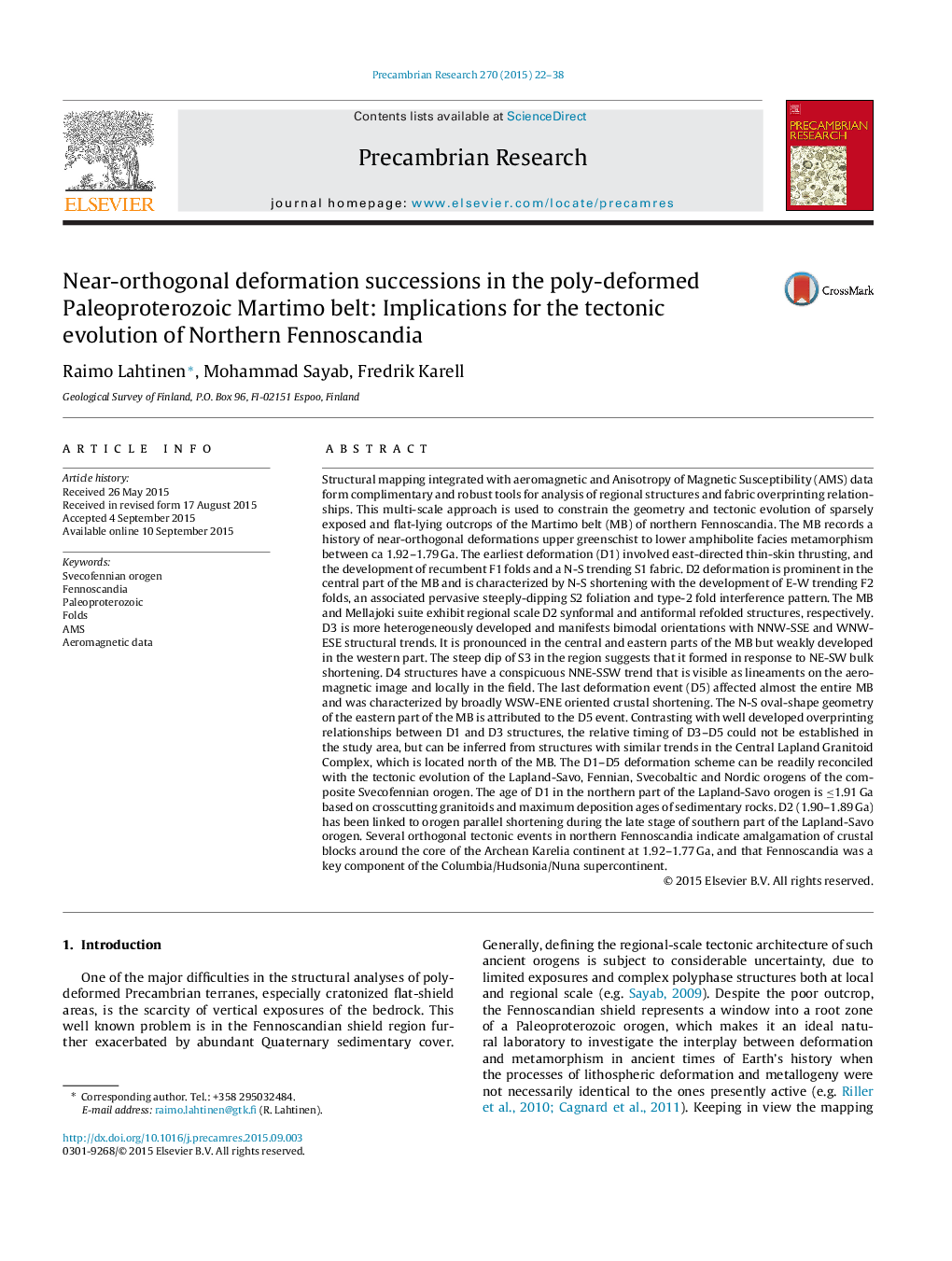| کد مقاله | کد نشریه | سال انتشار | مقاله انگلیسی | نسخه تمام متن |
|---|---|---|---|---|
| 4722453 | 1639605 | 2015 | 17 صفحه PDF | دانلود رایگان |

• The Martimo belt (Fennoscandia) manifests complex Paleoproterozoic tectonic evolution.
• Five near-orthogonal deformation successions (D1–D5) are identified.
• Each tectonic event is characterized by distinct bulk crustal shortening.
• Strong strain heterogeneity is partly due to the Archean basement involvement.
Structural mapping integrated with aeromagnetic and Anisotropy of Magnetic Susceptibility (AMS) data form complimentary and robust tools for analysis of regional structures and fabric overprinting relationships. This multi-scale approach is used to constrain the geometry and tectonic evolution of sparsely exposed and flat-lying outcrops of the Martimo belt (MB) of northern Fennoscandia. The MB records a history of near-orthogonal deformations upper greenschist to lower amphibolite facies metamorphism between ca 1.92–1.79 Ga. The earliest deformation (D1) involved east-directed thin-skin thrusting, and the development of recumbent F1 folds and a N-S trending S1 fabric. D2 deformation is prominent in the central part of the MB and is characterized by N-S shortening with the development of E-W trending F2 folds, an associated pervasive steeply-dipping S2 foliation and type-2 fold interference pattern. The MB and Mellajoki suite exhibit regional scale D2 synformal and antiformal refolded structures, respectively. D3 is more heterogeneously developed and manifests bimodal orientations with NNW-SSE and WNW-ESE structural trends. It is pronounced in the central and eastern parts of the MB but weakly developed in the western part. The steep dip of S3 in the region suggests that it formed in response to NE-SW bulk shortening. D4 structures have a conspicuous NNE-SSW trend that is visible as lineaments on the aeromagnetic image and locally in the field. The last deformation event (D5) affected almost the entire MB and was characterized by broadly WSW-ENE oriented crustal shortening. The N-S oval-shape geometry of the eastern part of the MB is attributed to the D5 event. Contrasting with well developed overprinting relationships between D1 and D3 structures, the relative timing of D3–D5 could not be established in the study area, but can be inferred from structures with similar trends in the Central Lapland Granitoid Complex, which is located north of the MB. The D1–D5 deformation scheme can be readily reconciled with the tectonic evolution of the Lapland-Savo, Fennian, Svecobaltic and Nordic orogens of the composite Svecofennian orogen. The age of D1 in the northern part of the Lapland-Savo orogen is ≤1.91 Ga based on crosscutting granitoids and maximum deposition ages of sedimentary rocks. D2 (1.90–1.89 Ga) has been linked to orogen parallel shortening during the late stage of southern part of the Lapland-Savo orogen. Several orthogonal tectonic events in northern Fennoscandia indicate amalgamation of crustal blocks around the core of the Archean Karelia continent at 1.92–1.77 Ga, and that Fennoscandia was a key component of the Columbia/Hudsonia/Nuna supercontinent.
Journal: Precambrian Research - Volume 270, November 2015, Pages 22–38